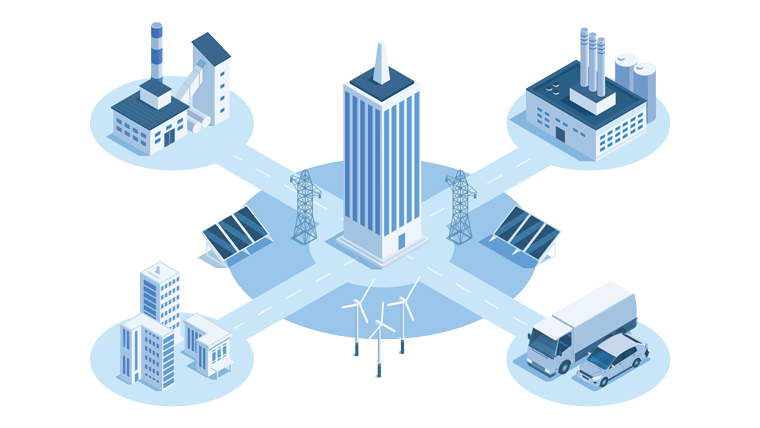Electrification refers to converting all on-site, direct burning of fossil fuels, such as natural gas, propane, oil, and gasoline, to electricity. In the face of the global climate crisis, the concept of electrification is gaining momentum as a way to make our communities more sustainable. It’s the only way to reduce carbon emissions to zero. Many buildings, facilities, utilities, and even entire municipalities are moving toward electrification, with good reason—electrification comes with plenty of benefits, including reduced greenhouse gas (GHG) emissions, increased resiliency for natural disasters, and dramatic enhancement of indoor air quality. In order to realize the benefits, beneficial electrification is a package of equipment replacement, efficient use of electricity with technologies such as heat pumps and induction heating, and sourcing the electricity from on-site or utility renewable energy such as solar.
However, that does not mean that going all-in on electrification is always the right thing to do. As this topic is being discussed more and more, several myths have evolved surrounding it. I want to explore some of these myths, and discuss why they exist and why they are not necessarily true.
Myth #1: We should electrify the entire country right away.
Why it’s a myth: While several states have been early adopters of electrification, including California, Washington, and other western states, plenty of other states are not able to fully switch to electric energy right now.
States need to consider what energy sources they are using the most right now, as this will affect how a switch would eventually take place, if at all. The states that have moved more toward electrification already are using clean sources of energy primarily, such as hydropower, wind, and nuclear, meaning they were already less reliant on fossil fuels, easing the transition. In states that rely heavily on fossil fuels, electrification is not advantageous due to emissions associated with fossil generation. We are also seeing some utilities lobbying to avoid gas bans, while others are lobbying to encourage them. Furthermore, before a country-wide shift toward electrification could be realized, we’d need an improved grid with more capacity and with continued resilience from power outages.
Myth #2: Electrification is always the best option.
Why it’s a myth: Moving forward with electrification without considering context is not always the best option. Electrification is only the better option when it saves three things: energy, money, and emissions. This is not always the case. Before deciding to electrify, it is necessary to look at energy usage vs. energy cost vs. the entire life-cycle of the decision. Efficiency should always come first, as electricity does generally cost more than fossil fuels.
When it comes to existing buildings, you need to first confirm you have an efficient building as well as the existing electrification capabilities to take on this new load before you electrify. You’ll also need to consider the life cycle cost of systems—it is not energy efficient to just throw everything out and start over so that you can electrify. If you electrify now and replace a relatively new condensing gas-fired boiler, for example, that would defeat the overall purpose of saving emissions in the long run. Develop a long-term plan for replacements of your key fossil fuel-based assets instead.
Myth #3: My building/campus is too big to electrify.
Why it’s a myth: There are increased challenges associated with electrifying larger buildings and campuses, such as increased electricity needs, which can lead to increased operating costs depending on natural gas rates vs. electricity rates. However, central heating systems serving multiple buildings are a good opportunity for electrification because economy of scale results in lower cost, diversity of load, and diversity of resources (e.g. waste heat from water sources, water lines, wastewater lines, industry, etc.) that all work in concert to increase the efficiency of the system. These increased electrical needs can be accommodated creatively through strategies such as shifting demand to non-peak hours, downsizing central plants, using thermal storage, using heat pumps, and taking advantage of low nighttime temperatures.
Overall, electrifying larger buildings is challenging, but not impossible—and will probably get easier moving forward as technologies progress and equipment becomes more readily available.
Myth #4: Going 100% electric is best.
Why it’s a myth: This is not always true. Even if you are going to pursue electrification, it is a good idea to secure back-up sources of power for critical operations. Batteries, generators, and other strategies can all be extremely useful to supplement electric energy in a crisis. This is especially important now, as the electric grid is not currently as reliable as we’d like it to be—as we move forward, this should change.
Additionally, as we progress more toward this strategy, various strategies, such as microgrids, will gain prevalence. This will help with reliability, because then users can be cut off from the utility and still have power, which would increase resilience for power outages caused by natural disasters or grid failure.
The Bottom line?
All of this is not to say that electrification is not worth it, or should not be done. Instead, this is just to shed some light on a few of the associated challenges, so that we can be realistic and thoughtful as we incorporate ways to reduce our collective reliance on fossil fuels. Mead & Hunt can help you on your facility’s decarbonization pathway with electrification, energy audits, renewable energy, embodied carbon planning and more.
This article also appeared in the July 2023 edition of Colorado Real Estate Journal’s Property Management Quarterly.



